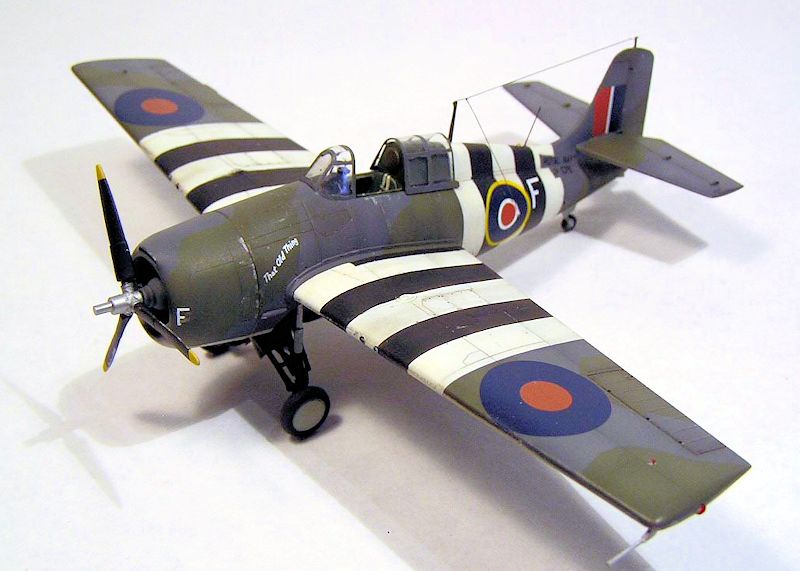
Hasegawa 1/72 Wildcat V
| KIT #: | 51326 |
| PRICE: | $14.00 or so |
| DECALS: | Two options |
| REVIEWER: | Fernando Rolandelli |
| NOTES: |

| HISTORY |
The Wildcat V (FM-1) was the first variant produced by Eastern Aircraft, to free
production space at Grumman for the Hellcat. It was generally identical to the
F4F-4, except for its reverting to four gun armament. The variant was also the
first to be officially named “Wildcat” in FAA service (to standardize with the
US Navy name) and also the first to be common to both services, previous Marks
had been quite different in detail and even in some prominent features (making
the build of a FAA Martlet a real nightmare for modelers)
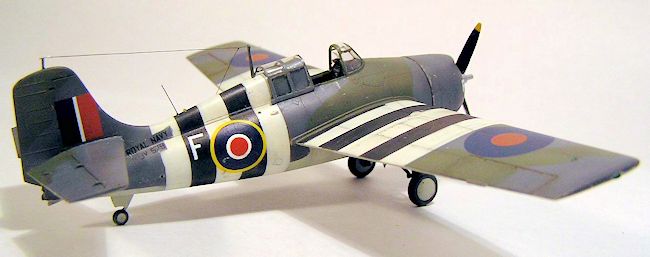 JV579, in service as “F” of 1832 Sqn, FAA, and named “That Old Thing”, is
probably one of the better known Wildcats in FAA service, a picture of it is
particularly widely shown. Part of contract
LL00036, when photographed, probably in June 1944, it was actually quite
new. The presence of the prominent “D-Day Invasion Bands” (or their “Operation
Dragoon” look-alikes) is rather enigmatic, as 1832 Sqn is mentioned as serving
at RNAS Eglinton (or “Eglington”), aka “HMS Gannet”, located in … Northern
Ireland!; while its “Battle Honours” include “Norway 1944”, “Atlantic 1944” and
“Arctic 1944”. For a “propaganda photoshoot” it looks rather sophisticated… that
led me into some “armchair research”. Delving into Sturtivant’s work, I found
that the machine passed through several squadrons, namely, 1832 (2.44); 846
(4.44) and finally 759 Sqn (as 846 was renamed, 12.44), finally scraping a wing
into the airstrip at NAS Yeovilton (unknown date). From Wragg’s history, it
looks like 846 Sqn (a TBR Sqn) inherited some of 1832 Sqn’s Wildcat, including
JV579, still (or at that time) designated “F”, “That Old Thing” (while it was
renamed “Y3V”, keeping the surname
“That Old Thing”, when in 759 Sqn); peaking to 10 machines, they were embarked
on HMS Tracker, but were disembarked when the latter had a collision on 03.06.44
(no indication of naval air station). Now, 846 Sqn does have “Normandy 1944”
among its “Battle Honours”. That could be the likely explanation: when depicted
in “Invasion Bands”, the machine was actually in 846 Sqn service, and not in
1832’s, as the Aeromaster decals and many captions quote.
JV579, in service as “F” of 1832 Sqn, FAA, and named “That Old Thing”, is
probably one of the better known Wildcats in FAA service, a picture of it is
particularly widely shown. Part of contract
LL00036, when photographed, probably in June 1944, it was actually quite
new. The presence of the prominent “D-Day Invasion Bands” (or their “Operation
Dragoon” look-alikes) is rather enigmatic, as 1832 Sqn is mentioned as serving
at RNAS Eglinton (or “Eglington”), aka “HMS Gannet”, located in … Northern
Ireland!; while its “Battle Honours” include “Norway 1944”, “Atlantic 1944” and
“Arctic 1944”. For a “propaganda photoshoot” it looks rather sophisticated… that
led me into some “armchair research”. Delving into Sturtivant’s work, I found
that the machine passed through several squadrons, namely, 1832 (2.44); 846
(4.44) and finally 759 Sqn (as 846 was renamed, 12.44), finally scraping a wing
into the airstrip at NAS Yeovilton (unknown date). From Wragg’s history, it
looks like 846 Sqn (a TBR Sqn) inherited some of 1832 Sqn’s Wildcat, including
JV579, still (or at that time) designated “F”, “That Old Thing” (while it was
renamed “Y3V”, keeping the surname
“That Old Thing”, when in 759 Sqn); peaking to 10 machines, they were embarked
on HMS Tracker, but were disembarked when the latter had a collision on 03.06.44
(no indication of naval air station). Now, 846 Sqn does have “Normandy 1944”
among its “Battle Honours”. That could be the likely explanation: when depicted
in “Invasion Bands”, the machine was actually in 846 Sqn service, and not in
1832’s, as the Aeromaster decals and many captions quote.
| THE KIT |
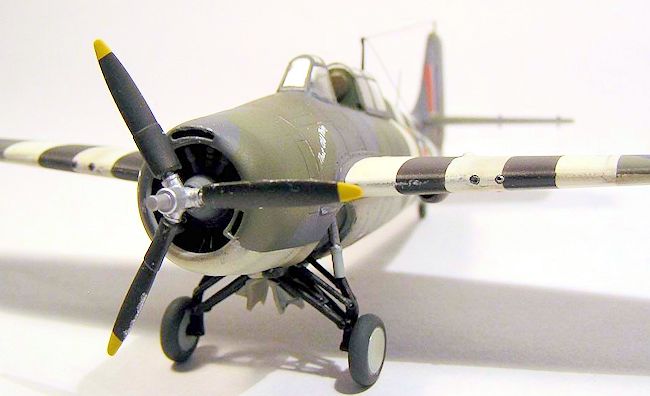 This is a rendition of the excellent Hasegawa kit, in its “F4F-3 Yellow Wing”
guise. Actually, it has nothing of the intended variant, exception made of the
(wrongly located for the type) four gun armament, the instructions having the
modeler fill the wingfold line and the outer wing guns. It makes, however, a
perfect F4F-4, provided you correct the pitot tube, and a good basis for a FM-1,
filling the outer guns. As the cockpit is suitably bare, and the big wheel well
is an empty, lonely space, I took an old True Details resin set, which performs
admirably and it is actually a mandatory addition. A Squadron vac canopy was
also added.
This is a rendition of the excellent Hasegawa kit, in its “F4F-3 Yellow Wing”
guise. Actually, it has nothing of the intended variant, exception made of the
(wrongly located for the type) four gun armament, the instructions having the
modeler fill the wingfold line and the outer wing guns. It makes, however, a
perfect F4F-4, provided you correct the pitot tube, and a good basis for a FM-1,
filling the outer guns. As the cockpit is suitably bare, and the big wheel well
is an empty, lonely space, I took an old True Details resin set, which performs
admirably and it is actually a mandatory addition. A Squadron vac canopy was
also added.
| CONSTRUCTION |
| COLORS & MARKINGS |
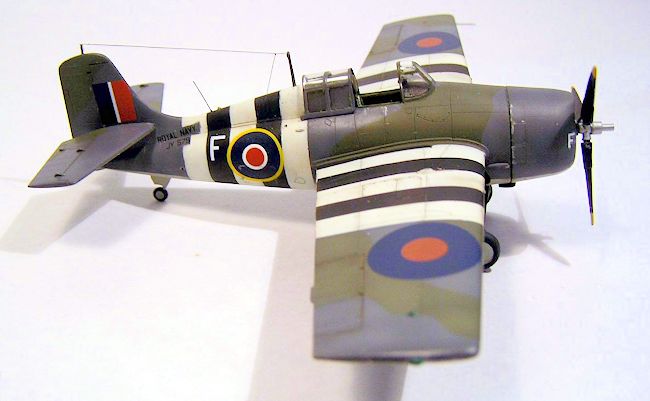
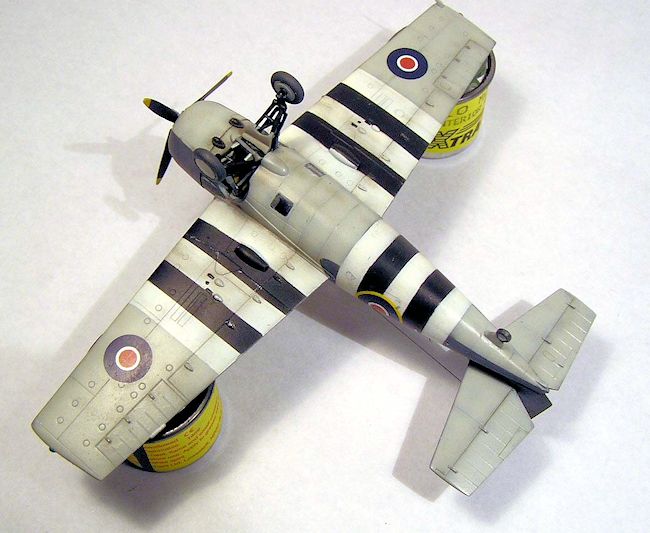 or scale effect. Then I
mask everything and apply the disruptive scheme colour. That way you avoid the
marks for the camouflage colour boundaries being visible below the bands, while
the dark base colour provides “instant weathering” for the White. In this scale
I use hard liquid mask, so boundaries would be very visible. I made the cut out
for the serial number in tape. Interior was thoroughly painted in US Interior
Green.
or scale effect. Then I
mask everything and apply the disruptive scheme colour. That way you avoid the
marks for the camouflage colour boundaries being visible below the bands, while
the dark base colour provides “instant weathering” for the White. In this scale
I use hard liquid mask, so boundaries would be very visible. I made the cut out
for the serial number in tape. Interior was thoroughly painted in US Interior
Green.
Decals came from a (nowadays) old Aeromaster sheet, 72-009. It provides both a big and a small “B” type roundel (for a Hellcat and a Wildcat respectively), but the well known photos of this machine shows big roundels, so I swapped them. To my annoyance, the round fuselage of the Wildcat prevented the C1 roundel to settle down, wrinkling helplessly until I made some strategically placed cuts (which then proved a chore to disguise in Roundel Blue paint!)
| CONCLUSIONS |
For a “not very involved build”, this kit was perfect. I wouldn’t even consider
building it without the TD set, more because of the wheel well than the cockpit,
for which I guess a PE set would suffice (especially leaving the hood closed). I
can only add to the praise by the Editor, here at
http://modelingmadness.com/scott/preww2/ywf4f-3.htm
| REFERENCES |
 “The Grumman Wildcat in FAA Service”, Bruce Archer,
Hyperscale.
“The Grumman Wildcat in FAA Service”, Bruce Archer,
Hyperscale.
“Aircraft of the Fleet Air Arm”, Ray Sturtivant and others, Air Britain Publications
“The Fleet Air Arm Handbook”, David Wragg, Sutton Publishing
“Royal Navy Aces of WW2”, Andrew Thomas, Osprey Publications
May 2014
If you would like your product reviewed fairly and fairly quickly, please contact the editor or see other details in the Note to Contributors.